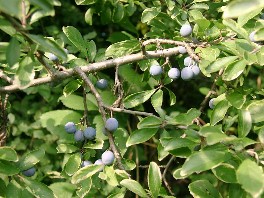 When walking in an european landscape you often see blackthorn-shrubs.
When walking in an european landscape you often see blackthorn-shrubs.
In spring time you can see thousands of white flowers, that cover all the shrub.
The fruits of the blackthorn are blue like plums but much smaller.
Before frost comes, the fruit tastes harsh. After some frosty days the fruit become sweeter.
Blackthorn helps against problems of the digestion.
Medicinal Uses
- Mucus-dissolvent
- Spasm-dissolvent
- Bladder problems
- Constipation
- Stomach weakness
- Stomach convulsions
- Coughs
- Fever
- Heart weakness
- Rashes
- Skin impurities
- Dropsy
Information
| Used Parts: | Flowers, Root Bark, Fruits |
| Substances: | Amygdalin, Hydrogen cyanide, Cyanidin, flavo-glycoside, tannic essence, Tannic acid, hyperoside, Kaempferol, Quercetin |
| Time to collect: | Flowers: April and May, Root: October, November, Fruits: Late autumn and winter |
Methods
You can cook a tea from the flowers of the blackthorn. Use it against constipation and for strengthening the stomach.The tea of the flowers can help also against skin problems, mucus in the lungs and against swollen feet.
The fruits can be cooked as a pulp and use it against constipation.
The bark of the root can be used against fever.
Plant description
 Blackthorn is a wild shrub in Europe.
It grows at the coast of forrests and in hedges.
Blackthorn is a wild shrub in Europe.
It grows at the coast of forrests and in hedges.
The blackthorn prefers limy ground.
The shrub becomes up to three meters (ten feet).
Young branches are hairy and have thorns at the end.
The blackthorn has small leaves that are elliptical.
Before the leaves grow in spring, the white flowers blossom. The flowers are very dense, so that one can only see the flowers and no more branches.
Until october the blue fruits ripen. The fruits are about one centimeter big. First the fruits taste very sour and afters some days of frost the become sweeter.
